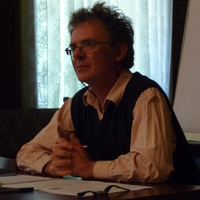Articles by David Nirenberg

This is an essay about the yearning of historians to find in the past exemplary lessons that migh... more This is an essay about the yearning of historians to find in the past exemplary lessons that might guide their own societies toward visions of the good. The essay will itself proceed by example: that of historical writing about a medieval Iberian society in which the coexistence of Muslims, Christians, and Jews produced two words, raza (race) and convivencia (living with, dwelling together), with their associated concepts. Historians of Iberia have generally treated these words and concepts as moral opposites. I will instead suggest that they are locked in intimate embrace. Let us start with the word convivencia, since the concepts the term encompasses feel less familiar for most historians. The Spanish word means literally "living with," but it has become a term of art among students of the Iberian Peninsula, designating specifically the living together of Muslims, Christians, and Jews. The word has come to stand (not without controversy) for a distinctive attribute of medieval society and culture that gave enduring shape to the possibilities of life and thought in the Iberian world. That world, we should not forget, extended in some early modern centuries over a large part of the globe, including much of Europe, the Americas, and even parts of Asia and Africa. If convivencia simply meant living together, or living together in Iberian contexts, it would probably not be the object of much discussion. But often enough, the possibilities of coexistence understood within the concept of convivencia are specifically valued positively. To pick a nonprofessional but influential example, the English-language Wikipedia page for "La Convivencia" defines it thus: An academic term, proposed by the Spanish philologist Américo Castro, regarding the period of Spanish history from the Muslim Umayyad conquest of Hispania in the early eighth century until the expulsion of the Jews in 1492. It claims that in the different Moorish Iberian kingdoms, the Muslims, Christians and Jews lived in relative peace. According to this interpretation of history, this period of religious diversity differs from later Spanish and Portuguese history when-as a result of expulsions and forced conversions-Catholicism became the sole religion in the Iberian Peninsula.1

The very title of this volume reminds us that in Egypt (and not only there) religious identities ... more The very title of this volume reminds us that in Egypt (and not only there) religious identities were linked to and shaped by political formations and impe rial projects, not separate from them. Nor is this a link age confined to Roman and post-Roman times, as any one can attest who wandered among the treasures of the British Museum's 'Egypt: Faith after the Pharaohs' exhibition that inspired this volume, many of which precede by centuries any nesting of Roman eagles on the Nile, and which include precious papyri from periods of Persian and Hellenistic rule over pharaonic lands. This linkage suggests something we might find dis concerting had we not imbibed, nolens volens, so much Foucault in our youth: that the representations of any religion produced at any given point in time are not, or not only, the product of any essential attribute of that religion, but rather (or also) the product of political processes of power and resistance. Many his torians today are inclined to accept such a viewdespite its implication that, since historians only have access to representations produced in the past, and are moreover also subject to the politics of their own present, every history they write would be doubly structured by power. Epistemology is above my pay grade. But what I would like to do in this essay is push towards its more radical implications ,this linkage between empire and religious identity, power and representation. If we take this linkage with imperial power seriously, what are the consequences for what we thought we knew about 'religious identity' in Egypt? (I put the term in scarequotes because it is not one I would choose, in part for the reason just mentioned, in part for others best left to a different essay.) In pursuit of that question I will focus on one case, and summarize how Judaism, across its very long

Based on a national survey of U.S. adults conducted six weeks into the COVID-19 pandemic, this ar... more Based on a national survey of U.S. adults conducted six weeks into the COVID-19 pandemic, this article investigates how crisis affects religious faith. Almost no Americans reported losing or a weakening of faith in response to the pandemic at this time. By contrast, nearly one-third of believers indicated that the coronavirus outbreak had strengthened their faith. We theoretically develop and empirically test three religious factors-theodicy, practices, and tradition-to explain variation in the strengthening effect of the COVID-19 pandemic among believers. Results from statistical models show that two theodicic interpretations-believing that God: is using the pandemic as a way to tell humanity to change; and will personally protect you from the virus-significantly increased believers' reports of faith strengthening, controlling for other factors. We also found that Black Protestants were more likely to report these interpretations, which in turn strengthened their faith in response to the pandemic.

This essay proposes a new approach to the history of race and religion: that of simultaneously co... more This essay proposes a new approach to the history of race and religion: that of simultaneously constructive and destructive comparison. It offers historical sketches of two biocultural processes, one in medieval Christianity (Iberia/Spain) and one in medieval Islam (Maghreb/North Africa), each of which can fruitfully be understood as ‘racializing’. Of each it asks similar questions. First, how did episodes of mass conversion or spiritual migration affect thinking about the heritability of certain characteristics within these religions? In
other words, did such episodes effect something that today we might call the racialization of religion? Second, how do these episodes relate to each other? Can we speak of their histories in terms of origins, or of a causal or genealogical relationship to each other? Can we say that any of the three religions involved in these episodes – Christianity, Islam, and Judaism – ‘invented race’ or practiced race-making?
') describes the interruption of his bath in Wadi Rumm (southern Jordan): a grey-bearded, ragged ... more ') describes the interruption of his bath in Wadi Rumm (southern Jordan): a grey-bearded, ragged man with a hewn face of great power and weariness, came slowly along the path till opposite the spring: and there he let himself down with a sigh upon my clothes spread out over a rock beside the path .... He heard me and leaned forward, peering with rheumy eyes .... After a long stare, he seemed content, and closed his eyes groaning, 'The love is from God; and of God; and towards God.' His low-spoken words were caught by some trick distinctly in my water pool. They stopped me suddenly. I had believed Semites unable to use love as a link between themselves and God.
David Nirenberg, “Sibling Rivalries, Scriptural Communities: What Medieval History Can and Cannot Teach us About Relations Between Judaism, Christianity, and Islam,” in Nina Caputo and Andrea Sterk, eds., Faithful Narratives (Ithaca: Cornell University Press, 2014), 63-79, 234-238











Uploads
Articles by David Nirenberg
other words, did such episodes effect something that today we might call the racialization of religion? Second, how do these episodes relate to each other? Can we speak of their histories in terms of origins, or of a causal or genealogical relationship to each other? Can we say that any of the three religions involved in these episodes – Christianity, Islam, and Judaism – ‘invented race’ or practiced race-making?
other words, did such episodes effect something that today we might call the racialization of religion? Second, how do these episodes relate to each other? Can we speak of their histories in terms of origins, or of a causal or genealogical relationship to each other? Can we say that any of the three religions involved in these episodes – Christianity, Islam, and Judaism – ‘invented race’ or practiced race-making?
There have been countless scripture-based studies of the three “religions of the book,” but Nirenberg goes beyond those to pay close attention to how the three religious neighbors loved, tolerated, massacred, and expelled each other—all in the name of God—in periods and places both long ago and far away. Nirenberg argues that the three religions need to be studied in terms of how each affected the development of the others over time, their proximity of religious and philosophical thought as well as their overlapping geographies, and how the three “neighbors” define—and continue to define—themselves and their place in terms of one another. From dangerous attractions leading to interfaith marriage; to interreligious conflicts leading to segregation, violence, and sometimes extermination; to strategies for bridging the interfaith gap through language, vocabulary, and poetry, Nirenberg aims to understand the intertwined past of the three faiths as a way for their heirs to produce the future—together.